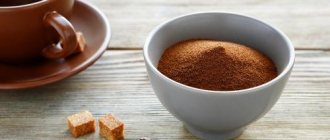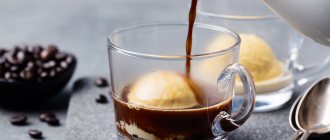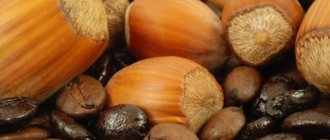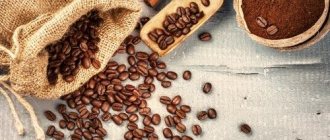Dependence of coffee taste on the degree of grinding of beans
When brewing coffee, the ground beans are extracted: the essential oils, caffeine and other compounds they contain that form the taste and aroma of the drink are dissolved in hot water. The finer the grains are ground, the greater the total surface area of the particles and the faster the substances contained in them are washed out.
From this it would seem that very fine grinding is the shortest path to success. But the problem is that the rate of dissolution of different substances is not the same.
Coffee extraction occurs in 3 stages:
- Isolation of substances responsible for the characteristic sourness characteristic of Arabica.
- Dissolving compounds in water that give the drink sweet, chocolate and fruity notes.
- Increased bitterness due to the saturation of the drink with tannins, caffeine, and breakdown products of chlorogenic acid.
The duration of the stages depends on the method of preparing coffee. For example, when brewing espresso, each stage takes 8–10 seconds, and if you prepare coffee in a French press, it takes more than a minute (total preparation time is 4–5 minutes).
The finer the beans are ground, the faster the first two stages pass and the last begins. If the extraction is not interrupted in time, the coffee will turn out too strong and bitter.
Features of grinding types and coffee preparation methods
The uniqueness of each person forces manufacturers of certain goods to present their products in an assortment sufficient for absolutely everyone to find something for themselves. This is the reason for the variety of coffee varieties in stores. However, the taste and quality of the finished coffee is affected not only by the variety, but also by grinding. His choice depends on the way you intend to prepare this unique and divine drink. And it doesn’t matter whether you buy bean coffee and grind it yourself or buy it already ground, every lover of the above-mentioned drink should know something about the types of grinding.
Types of coffee grinding
If you turn to different sources, you may be left bewildered: some claim that there are three main types of grinding (that is, particle sizes) of coffee, others insist that there are four, and still others even talk about five!
Agree, it’s difficult not to get confused. We will focus on the fact that there are five main types of grinding - and a sufficient number of additional ones. The main types include:
- Coarse grind. The size of coffee particles reaches 0.8 mm, but ideally should not exceed this figure. Extraction (brewing) occurs in 6-8 minutes. Coarse powder is ideally suited for use in piston coffee makers (French press) or coffee pots of various types.
- Medium grind . The size of coffee particles does not exceed 0.5 mm. This is the most “unpretentious” type of grinding, as it is suitable for almost any type of brewing. A drink from such a powder can be prepared either in a coffee pot or coffee maker, or in other known ways. It also turns out very tasty in a French press. Brewing medium-ground coffee takes 4-6 minutes.
- Fine grind. Particle size – no more than 0.3 mm. Extraction requires 1 to 4 minutes. Indispensable for coffee makers with filters.
- Fine espresso grind. As the name implies, it is used to prepare espresso in special coffee machines designed for brewing this particular drink. Special grinding in this case is required due to the special brewing process: in espresso coffee makers, a stream of hot water under high pressure passes through a filter with ground coffee. This happens in about 30 seconds, and during this time the required amount of flavoring and aromatic substances should be extracted from the powder.
- Ultrafine (powdery) grinding (pulverized). The particle size barely reaches 0.1 mm. A drink made from such powder is boiled in a cezve. It is this grinding that is necessary to prepare the famous Turkish coffee.
It would seem that since “medium” ground coffee is almost universal, why not purchase it exclusively? The fact is that the particle size affects the quality of the finished drink, and in this case everything depends solely on your preferences and time. Fine grinding gives the coffee a more refined, subtle taste. In addition, it is suitable for cooking methods that take little time. But coarsely ground coffee produces a drink “with character” - with a bright, complex, original, somewhat rough taste. It will take longer to cook. But you don’t need any special equipment: in some cases, a coffee pot is enough.
Features of coffee preparation
While preparing a drink in a coffee machine is not at all difficult, just follow the instructions for it, but not everyone knows how to do it in a Turk (or, as it is also called, cezve).
However, this is also not difficult. There are many options for making coffee over a fire in a Turk. So, in some recipes it is recommended to add sugar and spices exclusively to the finished drink, in others - before adding water to the cezve, in others - even before you add coffee. Some people stir the drink during the preparation process, while others think that this is strictly forbidden. The foam that forms on the surface when the liquid is heated is also dealt with differently: as soon as it forms, it is removed and laid out in cups, allowing a new one to appear, which is also removed, or left on the surface. The amount of ground coffee per cup depends on preference (and health) - from one teaspoon to a couple of tablespoons. And to reveal the taste, some people add a pinch of salt to the drink at the beginning of cooking...
But there are general principles for making coffee in a cezve. Copper Turk is ideal for preparing a delicious drink. But this does not mean that without it you cannot make good coffee. A brass Turk would also work perfectly.
Features of making coffee in a cezve
Use cold, even ice-cold water (spring, well, or filtered tap water). The finer the coffee grind, the better the result. The drink in the Turk is brewed over low heat.
- First, slightly heat the empty cezve over low heat, then pour ground coffee into it.
- Heat it up a little more, then you can pour in the water (if you are using spices and sugar, you can add them to the heated ground coffee, stir, put it back on the stove for a while and then pour in the liquid).
- Do not fill the Turk with water completely, but only to the narrowest point.
- When the coffee begins to rise, the Turk should be removed from the heat just at the moment when it seems to begin to “run away.” It is best to heat it to this temperature several times, so the drink will be more aromatic. Under no circumstances should coffee boil.
- Pour the finished drink into heated cups (to heat, you need to pour boiling water into them and then pour them out) along with the grounds.
- Making coffee on sand is carried out in approximately the same way as on a fire, only the cezve is not placed on the burner, but is buried in the heated sand. This way the drink warms up more evenly, which provides it with a special taste.
At home, you can take clean fine sand, pour it into a deep frying pan or pan, heat it on the stove and bury the Turk in it so that there is also a layer of sand under the cezve. If it is not enough, mix with salt. Otherwise, the process is practically no different from cooking on a burner, except that you will have to not just place the Turk, but bury it, and several times. Before serving, let the drink steep for a couple of minutes in the cezve.
French Press Grinding
Another popular option for making coffee is to use a special coffee pot called a French press. Connoisseurs claim that this is one of the most delicious and aromatic methods. In this case, coarse or medium grind coffee is perfect. The water with which the powder will be brewed should reach 90-96 degrees.
- Before pouring coffee into the vessel (every 220-250 ml of water you will need 4 tablespoons of coffee, however, it’s a matter of taste), warm it up: rinse with hot water and wipe.
- Pour hot water over the powder so that the liquid does not reach the edges of the flask, leaving a distance of about 2 fingers.
- Stir the drink with a wooden spoon (stick), cover with the lid, turning it so that the spout of the coffee pot is closed.
- The piston must be raised.
- Let the coffee brew for about 3-4 minutes, then you can stir it again, return the lid, but this time so that the spout of the vessel opens.
- Now you can carefully and slowly lower the plunger and pour the drink into the heated cups.
We wish you to find the best and most delicious way to make coffee for yourself!
Degrees (types) of coffee grinding
There are 5 main grind levels for coffee:
- ultra-fine grinding (pulverized, or “to dust”) – ground coffee resembles ground cinnamon;
- fine espresso grind – like iodized salt;
- fine grind – like coarsely ground powdered sugar;
- medium grind – like sugar;
- coarse (course grind, coarse) – like sea salt.
Grinding coffee for brewing in a cup
If you don’t have a coffee maker at hand, you can brew the drink in a cup: the method is called “Warsaw style.” Ground coffee is poured with hot water, stirred, covered with a saucer and left to steep for a few minutes. The more crushed the grains are, the better.
Especially for brewing in a cup, the coffee chain Starbucks even produces ultra-fine ground coffee in vacuum packaging, advertising it as a replacement for instant coffee. This coffee grind is very good for brewing in a cup. But if you cannot grind the grains into dust, regular fine grinding will do.
Adjusting the coffee strength in the coffee machine
Strength in terms of automatic coffee machines is the amount of coffee ground for one pour and, accordingly, for one coffee tablet.
The more “grains” or divisions are selected in the setting, the more beans the coffee machine will grind for one preparation process. More ground coffee means a richer drink, a brighter taste, all shades are enhanced. Most models estimate the required number of beans to grind not only by the strength you set; there are special adjustment technologies, but the general meaning is always the same: more strength means more coffee in the coffee tablet, through which hot water is poured in the brewing chamber. This setting is always independent of the drink volume and does not affect it in any way.
As a rule, with the rarest exception (when the consumer prefers light coffee), you can safely use the maximum strength. The second contraindication is that you are trying to save on grain, this happens often. If you have a similar task, then you can try to reduce the strength (reduce bean consumption) and at the same time reduce the grinding. To some extent, these actions cancel each other out, although in terms of meaning and the result in the cup they are not 100% interchangeable.
If you are interested in the approximate strength values for each brand of coffee machine translated into grams of beans, then I wrote about this in the profile material.
Grinding Turkish coffee
In a Turk, it is necessary to brew ultra-finely ground coffee. The grain particles form a suspension, which makes the drink seem thicker. You need to wait a bit for it to settle. It is almost impossible to grind grains so finely at home. You have to either buy ready-made, ultra-finely ground coffee, or grind it in specialized stores. It is advisable to use coffee powder as quickly as possible: it wears off within a few hours.
Grinding for Turks (dezva)
Fine and medium grind coffee is also suitable for preparing a drink in a Turk.
How does grinding affect the taste of coffee?
When researching information about what the correct grinding of coffee in a coffee machine affects, several interesting facts can be identified. 1. For a drip type machine, experts recommend using coarse grinding. This will have a great effect on the strength and taste of the finished drink. The coffee will not be bitter and will not seem over-roasted. 2. Medium grind – ideal for coffee time in the middle of the day. The strength will be at a medium level, perfect for making drinks with milk - latte or even cappuccino. 3. Fine grinding – for preparing coarse and masculine drinks. The end result is a very strong and invigorating espresso that you can drink without wincing. 4. “Dust” - this type of grinding can be classified as ultra-fine, since in the end very small particles should remain. This option is more suitable for those who are tired of drinks in bags and granules and want to please their partner with a homemade Turkish drink. The taste will be no worse than in an expensive coffee shop.
The choice of grinding depends on the taste preferences of the user. However, it is worth recalling that the most important thing is to learn how to prepare espresso correctly, since these are the “basics”.
The choice of grinding depends on the taste preferences of the user.
Grinding coffee for espresso
A fine espresso grind has been invented especially for coffee machines: slightly finer than a regular fine grind, but larger than an extra-fine grind.
Ultra-fine ground coffee cannot be used for brewing espresso: the drink turns out bitter, with the smell of burnt beans, and small particles clog coffee machine filters.
Experienced baristas recommend:
- at high humidity, low temperature and atmospheric pressure, grind coffee coarser;
- At low humidity, high temperature and atmospheric pressure, use a finer grind.
At high humidity, the particles swell and stick to each other. Pre-wetting time is reduced, tannins begin to release earlier, and if the beans are ground too finely, the coffee will taste bitter. In hot weather, natural moisture evaporates from the grains, which causes the pre-wetting period to increase. If the coffee is ground too coarsely, the drink will have a noticeable sourness.
Espresso grinder
There are no standards for fine grinding espresso. It is selected experimentally: coffee is brewed and the extraction rate is assessed. The ideal time for preparing 25 ml of espresso is 25 seconds, an error of ± 3 seconds is allowed. You need to stock up on electronic scales and a stopwatch. The cup into which the coffee flows is placed on the scales.
Tamper for tamping ground coffee
If the drink flows out slowly (25 ml is not collected in 28 seconds), and the stream is too thin or intermittent, it means the grind is too fine. If a shot of espresso comes out faster than 22 seconds, it means the grind is coarse, the water only washes the particles, and the drink becomes weak. In this case, the coffee grinder is adjusted to reduce the particle size.
Rules: how to grind coffee in a coffee grinder
The process of preparing a drink from grains is simple, but it has its own rules and tricks. Having studied them, you can easily prepare a drink that will satisfy the taste of the most demanding coffee lover.
- You should not make extra coffee. The quality of ground raw materials deteriorates faster than when stored in grains.
- Decide on the type of grinding. The time of grinding and use of finished raw materials must comply with generally accepted standards.
- Take the required amount of grains. On average, one cup of the finished drink contains 2 tablespoons of grains.
The taste of the prepared powder will not deteriorate if it is sealed and placed in the refrigerator.
Important! Using a manual coffee grinder instead of an electric one requires more time and effort, but the beans do not overheat and the signature aroma of coffee is unique.
Grinding coffee for geyser coffee makers and AeroPress
To brew coffee in a geyser coffee maker or AeroPress, the grinding should be fine or medium (the size of the fraction is the same as that of cane sugar). The finer the grind, the stronger the coffee, but superfine grind powder will clog the AeroPress filter.
Grinding for geyser coffee maker and AeroPress
Adviсe
Do not forget that you should not use electrical appliances for a long time for purposes other than their intended purpose; coffee beans are strong and can damage equipment. After use, devices should be washed thoroughly. Use them carefully and only as a last resort.
Both bean and ground coffee must be stored under special conditions so that it does not lose its properties: sealed storage in a cool place without light, low humidity. Ground coffee retains its properties in the correct packaging for a week, but it is better to store coffee in beans.
Remember that it is better to grind your coffee before using it. In this case, you get delicious and aromatic coffee.
Grinding coffee for pour-overs and Chemex
It is believed that medium grind coffee is suitable for pour overs: a little coarser than for an AeroPress. If disposable paper filters are used, the grind can be finer, as long as the water passes through the grounds. But in pour-overs with metal or fabric filters, finely ground coffee cannot be brewed: bean particles fall through the holes.
Grinding for pour-over and Chemex
To prepare a drink in a Chemex, the grains are ground even coarser than for a pour-over (the fractions should be the size of large sugar crystals).
How to choose the best Turkish coffee
Each consumer is guided by his own criteria when choosing Turkish coffee. It can be taste and aroma, strength, price; for some, the manufacturer is important, while others fall for promotional offers, saving not only on price, but, often, on quality.
Coffee experts identify the following main selection criteria:
- taste qualities;
- price, relationship with quality;
- variety;
- growing region;
- grinding;
- degree of doneness;
- brand popularity.
If taste and price are subjective things, then other criteria need to be studied in order to choose the most optimal product for yourself.
Coffee grinding for drip coffee makers
Drip coffee makers typically brew coffee that is ground coarser than for a Chemex, but slightly finer than a coarse grind.
Exactly the same grind is good for cupping (brewing in a cup) in the Brazilian way: open method. Coffee is poured into a cup, poured with hot water and stirred. After 4 minutes, remove the floating particles of grounds with a spoon.
Grind for drip coffee maker
Why coffee should be a bean
The coffee fruit is a storehouse of valuable chemical elements, securely hidden under a hard shell. In particular, these are essential oils that are responsible for the incomparable aroma of the finished drink. Some components are responsible for your favorite taste, others for the vigor that a long-awaited cup gives.
- This is interesting: Why coffee invigorates
When the grain is opened, much less crushed, this entire noble bouquet gradually begins to evaporate. And this is provided that the product is not subjected to any other processing at the factory. The strictest secrecy of production leaves the consumer only to hope for the purity of the composition. So, is ground or bean coffee still a valid question?
With grains everything is very clear. These are whole raw materials that do not allow dishonest goods. Low-quality coffee, crushed chicory and more are mixed into the inexpensive powder composition. You can recognize unclean contents by the smell and unpleasant taste of the finished drink.
- Don't miss: Which is healthier, coffee or chicory
The financial benefits of factory grinding are also very questionable, if you look at it. 250 g of whole berries will yield more cups of coffee than the same volume of crushed packaging. Freshly ground grain will “open up” better and impart more flavor and aroma to the water. This means you will need less per cup.
Experts unanimously assure that it is better to buy coffee beans and grind them yourself. A serving is for one time, you cannot stock up, or the homemade ground delicacy, just like the store-bought one, will lose all its pleasant properties. When an electric coffee grinder is running or a manual one is spinning, the whole room smells of natural grain. The anticipation of tasting makes your favorite drink even tastier!
Grinding coffee for French press
Usually, the coarsest grind of coffee is recommended for brewing in a French press: the fractions should reach the size of crystals of sea salt or even pearl barley. But the drink made from beans of this type has a slightly sour taste, which not everyone likes.
A French press with a nylon filter can brew medium-ground coffee. If you buy an American press, then even finer ground grains will do. This modification of the French press is equipped with a special chamber for coffee. An AeroPress filter is placed in it, and particles do not get into the drink.
The basic rule for choosing grinding
If you find it difficult to determine what grind you need, then follow the golden rule. The shorter the interaction time between ground coffee and water, the finer grind you will need. And vice versa: the longer the brewing or infusion process takes place, the larger the grain particles should be.
Table. How to choose coffee grind?
| Cooking method | Coffee recipe | Suitable grind size |
| Turk | Oriental coffee | Ultra-fine, feels like powder |
| Coffee machine | Espresso and drinks based on it | Thin, feels like extra salt |
| Geyser, carob and drip coffee maker | Black coffee | Medium, universal, feels like river sand or fine sugar |
| Chemex, pour over, aeropress | Alternative brewing | Medium coarse, feels like regular table salt or brown sugar. |
| Cupping | Coffee in a cup | Large, to the touch - slightly larger than ordinary salt, large fractions may appear, |
| French press | Coffee by infusion method | Very coarse grind, feels like pickling, coarse salt. |
Choosing a coffee grinder
Truly aromatic coffee can only be made from freshly ground beans. In order not to spoil the taste of the drink, it is important not only to determine the degree of grinding, but also to choose the right coffee grinder.
There are two types of coffee grinders:
- rotary (knife) – electric;
- millstones - manual and electric.
Features of rotary coffee grinders
A rotary coffee grinder is equipped with knives that, when rotated, crush the coffee beans. The problem is that the grinding is extremely uneven: some particles are much larger than others. With such quality of bean grinding, all the subtle nuances of taste of even the most expensive coffee are lost.
Another drawback of the devices is overheating of the coffee. To get a homogeneous powder, keep the coffee grinder on for too long and shake it periodically. As a result, small particles become very hot, practically burn, and the drink takes on the smell of burnt grains.
To make the structure of the powder more uniform, after grinding the grains in a coffee grinder, they are sifted through a sieve. This should definitely be done if the mixture contains Arabica and Robusta: Robusta beans are harder than Arabica, and grinding uniformity can only be achieved by sifting.
To avoid overheating of the particles, coffee must be ground in several passes, periodically turning off the device and allowing it to cool:
- for fine grinding (including espresso) – turn on the device for 4–5 seconds 15–20 times;
- for medium grinding – 2–3 seconds 10–12 times;
- for coarse grinding - 3 seconds 6-8 times.
After turning off, you need to open the coffee grinder and mix the contents of the chamber with a teaspoon.
Burr coffee grinders
Burr coffee grinders, unlike rotary ones, do not chop coffee beans, but grind them, which ensures high-quality grinding.
Manual millstone coffee grinders came into use back in the Middle Ages. Their design has remained virtually unchanged.
There are 2 types of manual burr coffee grinders on sale:
- European type (similar to a mill);
- Turkish type (cylinder with a rotating handle).
Such devices grind, although efficiently, slowly: the process takes 1–5 minutes. There is no dispenser, so you need to weigh the coffee before grinding it. Using a screw, the distance between the millstones is adjusted by eye, changing the degree of grinding. Models with steel, cast iron, ceramic and stone millstones are available. Stone and ceramic millstones are considered the best: they do not impart extraneous odors to the ground coffee.
Grinding devices
Manual coffee grinder
Coffee grinders are manual and automatic. The difference between the two is that the manual device is activated by a handle. It is rotated clockwise and the millstones are activated.
The advantage of such coffee grinders is their low cost and autonomous operation. You don't have to look for an outlet or buy batteries.
The disadvantage is that you cannot choose the degree of grinding and obtain powder fractions. Only a medium grind is obtained.
It will not be possible to achieve perfectly ground beans. Some of them will not be completely crushed.
Another disadvantage is that you will have to make an effort to manually grind a large number of grains.
Interesting! What is Robusta and how is it different from Arabica?
Electrical device
This coffee grinder is often equipped with an additional function - you can select the degree of grinding using the switch lever.
Also among the advantages is that the unit works independently and ideally grinds grains.
The downside is that it works on the network and the high price.











